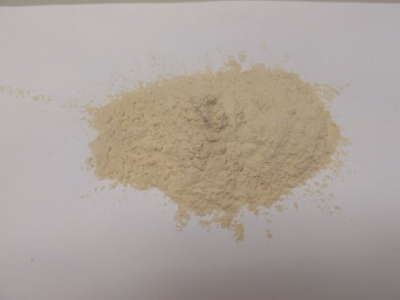New process looks to improve soybean meal for fishfeed

In an effort to create more demand for soybeans, the Ohio Soybean Council is supporting development of an improved soybean meal aimed at the aquafeed industry.
The revamped meal, called EnzoMeal, is put though an enzyme treatment to reduce the amount of anti-nutritional factors (ANF) that can impair fish digestion, said Barry McGraw, Ohio Soybean Council director.
“In the feed area we were a little more focused on fish feed because of the need for protein,” he told us.
The effort is part of the group’s investments in long-term research aimed at improving the use of soybeans and related products like soybean meal “What the council does is look at futurist products that could help create demand and [whether to] put the money and the time in to see them through,” he added.
The Council is currently looking to license the technology, he said.
Feeding trials
Initial feeding studies using the new soymeal were done through several universities with trout, yellow perch and Pacific White Shrimp, said McGraw.
“We have other fish studies going on with sea bass in Australia, and salmon in Norway, and largemouth bass in Kentucky and we’re [also] looking at catfish,” he said.
Two diets for rainbow trout contained inclusion levels of the meal at 18 and 33% and comparative diets, reported the Council in one study. Results from 10 weeks feeding of all the diets generated similar results, showing that high inclusion of the meal is possible in trout feeds without decreasing performance, said the Council.
In a yellow perch study, tested feeds included diets that replaced 50% and 100% of the dietary fishmeal with EnzoMeal, the researchers said. The control, a fishmeal based diet, and a diet using 50% EnzoMeal with or without an enzyme supplement, supported the best fish growth and nutrient utilization.
In studies with shrimp, the group getting the 100% EnzoMeal diet appeared slightly lighter, but not statistically different than those getting a fishmeal diet, said the researchers.
The Council has also tested scaling up production, generating about 3,000lb initially, and expanding that to a run of 5,000lb, said McGraw. Production of about 10,000lb is set for early 2017.
Reducing ANF and development
The Council started its research based on the idea that there should be a way to reduce the amount of anti-nutritional factors in soybean meal without damaging the amino acid levels, said McGraw. It reached out to the research company Battelle with that idea.
“They developed an enzyme cocktail to remove the oligosaccharides,” he said. “It’s a non-fermentation-[based] process.”
The process, which is being patented, does not require specialized machinery, he said. And the technology used allows for a reduction in the amount of carbohydrates and phytic acid in the meal while boosting the average protein content.
The Council reports that conventional, commercial soybean meal has a protein content of about 46%, carbohydrates at about 40% and oligosaccharides at about 15%, while this "innovative" process produces meal that is 56% protein, 28% carbohydrate and less than 0.05% oligosaccharides. Additionally, while the phosphorus levels are the same in both meals, the phytic acid is reduced by about 36%, it reported.
Additionally, the product remains similar to soybean in physical composition, said McGraw. “My understanding is they haven’t had any issues with extruding it or formulating it,” he added.
Related news
 Tilapia show performance, health boost from essential oil use
Tilapia show performance, health boost from essential oil use Clove basil, ginger essential oils boost weight gain, growth, immune functioning in disease challenge tilapia, say researchers.
 What can fish protein hydrolysate offer farmed turbot?
What can fish protein hydrolysate offer farmed turbot? Up to 10% of fishmeal can be replaced in a high plant protein diet and still support turbot growth, say researchers
 Researchers find ideal histidine levels to boost tilapia growth
Researchers find ideal histidine levels to boost tilapia growth Targeted histidine levels point toward improved growth, muscle development in Nile tilapia, say researchers.